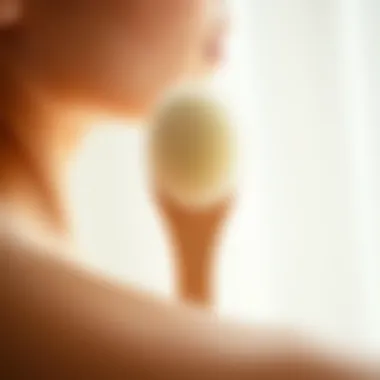Exploring Soft Exfoliating Brushes for Skincare and Fabrics


Intro
Soft exfoliating brushes have grown increasingly popular in both skincare and fabric care routines. Their gentle yet effective design allows for a multidimensional approach to care that can enhance the overall experience and maintenance of personal items and skin alike. Understanding how these brushes can be utilized helps individuals make informed choices that cater to their specific needs while keeping sustainability in mind. This article delves into the intricacies of selecting the right brush and techniques, offering a comprehensive view of their impact on our daily rituals.
Fabric Knowledge
When it comes to caring for garments, knowledge about different types of fabrics is crucial. Just like seasons change, so do the needs of various materials. Knowing these requirements can extend the life and appearance of your clothes.
Types of Fabrics
Fabrics generally fall into two main categories: natural and synthetic. Here are some key examples:
- Cotton: Soft and breathable, this fabric is a staple in many wardrobes. It can handle scrubbing without damage, making it ideal for everyday wear.
- Silk: Luxurious yet delicate. Care must be taken with a soft brush, focusing on gentle motions to prevent any damage.
- Wool: Warm and cozy, wool can be prone to pilling. A soft brush can help remove these tiny balls of fluff without compromising the integrity of the fabric.
- Polyester: A durable synthetic that can withstand a bit more wear and tear. Its resilient nature means that it can handle more vigorous brushing, although it is wise to test an inconspicuous area first.
How to Care for Different Fabrics
Each fabric type has its unique requirements when it comes to cleaning and maintenance. Here’s a brief look at how to properly care for these materials:
- Cotton: Use a soft brush to remove dirt and lint after each wear. Wash regularly at the right temperature to maintain its quality.
- Silk: Always brush gently in one direction. Consider dry cleaning or hand washing to ensure it stays delicate and beautiful.
- Wool: Brush after each wear to keep it looking fresh. Hand washing in cool water with minimal agitation is recommended to prevent shrinking.
- Polyester: Clean easily in a washing machine, but using a soft brush can help maintain its vibrant look even after many washes.
Techniques for Skincare
Just like fabric care, skincare is an art that requires understanding and practice. Soft exfoliating brushes can play a pivotal role in achieving glowing skin. Here's a concise guide on how to incorporate them into your routine:
- Choosing the Right Brush: Consider bristle softness and length. A longer bristle is suitable for sensitive skin, while thicker ones may be better for tougher areas.
- Brush Direction: Always brush in upward and circular motions to encourage blood circulation and stimulate the skin effectively.
- Frequency: It's wise to start slow; using the brush once a week can help gauge how your skin reacts.
"The key to both delicious textiles and radiant skin lies in a tailored approach that respects the material or surface you are caring for."
Sustainable Choices
As mindfulness over environmental impact increases, the demand for sustainable materials is on the rise. Soft exfoliating brushes made from eco-friendly materials like bamboo or natural bristles can align with a more sustainable lifestyle. It's essential to consider longevity and end-of-life options, as some brushes are biodegradable or recyclable.
Engaging in practices that honor both your skin and the materials you wear is the cornerstone of modern self-care and environmental consciousness. As you learn how to properly utilize soft exfoliating brushes in both areas, it’s clear that attention to detail can yield remarkable results.
Understanding Soft Exfoliating Brushes
In the realm of personal care, soft exfoliating brushes play a significant role that often goes unnoticed. By integrating these tools into daily routines, individuals can significantly improve both their skincare practices and the maintenance of fabrics. The importance of understanding these brushes lies not only in their ability to enhance skin and fabric aesthetics but also in their functionality and sustainability.
Definition and Purpose
Soft exfoliating brushes are designed to gently slough away dead skin cells and debris from various surfaces, whether it's one's face or cherished clothing. Their primary purpose is to promote skin renewal and cleanliness without harm. While many individuals overlook them in favor of harsher scrubs, soft brushes offer a kinder alternative, allowing for effective exfoliation without risking irritation. In fabric care, these brushes help in removing lint and dirt, ensuring garments maintain their pristine appearance over time.
History of Exfoliation Tools
Exfoliation, in various forms, has been part of skincare for centuries. The earliest known tools date back to ancient civilizations where artisans crafted brushes from natural materials for body care. Egyptians, for example, used coarse grains combined with friction tools to achieve smoother skin. Fast forward to today, and we have a plethora of options in soft exfoliating brushes, reflecting advancements in materials and techniques. Understanding this historical context helps to appreciate the evolution and significance of these tools in modern beauty and fabric care.
Types of Soft Exfoliating Brushes
Within the category of soft exfoliating brushes, several types cater to different needs and preferences. The most common ones include natural bristle brushes, synthetic bristle brushes, and eco-friendly options.
Natural Bristle Brushes
Natural bristle brushes are often preferred for their softness and ability to adapt to different skin types. Made from animal hair, such as goat or horse, these brushes provide a gentle touch that’s particularly beneficial for sensitive skin. Their unique ability to maintain the skin's natural oils while effectively exfoliating is a key factor in their popularity. However, it’s essential to consider ethical sourcing when selecting natural bristle options, as sustainability can vary.
Synthetic Bristle Brushes
On the other hand, synthetic bristle brushes, crafted from man-made fibers, often offer durability and versatility. They can be tailored for specific exfoliating needs, making them a favorite among many skincare enthusiasts. Their ability to withstand water and various cleaning agents means easier maintenance, which is an attractive feature for busy individuals. Some might argue these brushes lack that gentle touch of natural bristles, yet they provide a consistent exfoliation experience without variability in texture.
Eco-Friendly Options
With growing awareness of environmental impact, eco-friendly options have gained traction. These brushes can be made from bamboo handles and recycled synthetic fibers. Their commitment to sustainability aligns well with current trends in mindful consumerism. While they might sometimes compromise on softness compared to their natural counterparts, their overall environmental benefits make them a worthy choice. Choosing eco-friendly brushes not only supports personal care but also reflects a broader commitment to preserving the planet.
In summary, understanding the various types of soft exfoliating brushes and their unique attributes empowers individuals to make informed choices tailored to their skincare and fabric care needs. This knowledge forms a solid foundation as we delve deeper into the specific benefits these tools bring.


Benefits of Using a Soft Exfoliating Brush
The realm of skincare and fabric care is enriched by soft exfoliating brushes, which serve important roles in both domains. Understanding their benefits helps illuminate why these brushes are more than just a cosmetic tool; they play a pivotal role in personal hygiene and garment maintenance. Through careful consideration of several key benefits, one can appreciate their relevance in daily routines.
For Skincare
Enhancing Skin Texture
One of the most notable benefits of using a soft exfoliating brush is its ability to enhance skin texture. These brushes gently buff the skin's surface, leading to a smoother feel. By removing dead skin cells, the brushes reveal fresh skin underneath, contributing to a more even tone. This process can significantly enhance the overall appearance, making smoothness a sought-after characteristic for anyone wanting flawless skin. Notably, this tool is particularly cherished for its efficiency and ease of use; it doesn’t require extensive effort or time, making it a favored choice in personal care routines.
Promoting Cell Renewal
Another compelling aspect of soft exfoliating brushes is their role in promoting cell renewal. The increased circulation created during the exfoliation process encourages the skin to shed old cells and generate new ones. This is crucial for maintaining a healthy complexion, as fresh cells are vital for a vibrant appearance. Alongside improving skin elasticity, this feature makes the brushes a preferred instrument for those actively seeking anti-aging benefits. However, it is essential to moderate use to avoid irritation, which is why many users opt for brushes with softer bristles designed for delicate skin types.
Improving Blood Circulation
Soft exfoliating brushes contribute to improving blood circulation in the skin. As one performs gentle circular motions with the brush, it stimulates the blood flow beneath the surface. This increased circulation not only nourishes skin cells but also fosters a natural glow. Regular use can lead to an invigorated complexion, shining light on why so many skincare aficionados consider this brush essential. Nevertheless, it is advisable for users to listen to their skin's response and tailor frequency of use accordingly.
For Fabric Care
Removing Lint and Debris
When it comes to fabric care, soft exfoliating brushes are indispensable for removing lint and debris from clothing. Their gentle bristles effectively lift away unwanted particles without damaging delicate fabrics. This is a particularly useful characteristic for those wanting to keep their cherished garments looking fresh and clean. Many find that this quick and straightforward solution saves them considerable time compared to traditional methods of cleaning. Plus, it’s often preferred over sticky rollers, lending a sustainable and reusable alternative.
Extending Fabric Lifespan
Proper maintenance extends the lifespan of fabrics, and that’s where soft exfoliating brushes shine. By regularly brushing clothes, one can prevent fabric pilling and wear, ensuring that garments maintain their original charm for much longer. This property not only highlights the utility of such brushes but also promotes sustainability by reducing the need for constant replacements. One can rest assured knowing their favorite pieces are cared for without resorting to chemical treatments or abrasive methods that may cause harm.
Maintaining Appearance of Clothing
An additional benefit of using soft exfoliating brushes is their contribution to maintaining the appearance of clothing. Regular use helps preserve colors and fabric integrity. Many individuals find their clothes looking fresher and more vibrant, making them feel good about their wear. It can effectively remove signs of age or wear, resulting in a polished finish that’s often sought after for professional appearances or social gatherings. However, it's important to consider the type of fabric, as some materials may require specific care instructions to avoid damage.
In summary, soft exfoliating brushes provide valuable benefits for both skincare and fabric care, making them versatile tools worth integrating into one’s routine. Their capacity to enhance skin texture, promote cell renewal, improve circulation, and maintain fabric beauty is noteworthy.
Choosing the Right Soft Exfoliating Brush
Selecting an appropriate soft exfoliating brush can make all the difference in your skincare and fabric care regimen. It's not a one-size-fits-all scenario, as various factors contribute to getting the most out of these tools. Understanding your skin type and the materials of the fabrics you handle is essential for maximizing effectiveness and minimizing potential damage. A well-chosen brush can enhance your exfoliation routine and make fabric maintenance significantly easier.
Skin Type Considerations
Sensitive Skin
For those with sensitive skin, the choice of a soft exfoliating brush is particularly crucial. This skin type often reacts adversely to harsh treatments, so using a brush with ultra-soft bristles is advisable. A suitable brush can gently remove dead skin cells without causing redness or irritation. Its key characteristic lies in its softness, allowing for a soothing scrub that enhances circulation while being devoid of harsh abrasives. With sensitive skin, the right tool can provide a significant advantage by promoting a healthier complexion without exacerbating existing irritations.
Oily Skin
On the flip side, individuals with oily skin may find certain benefits from incorporating a soft exfoliating brush into their routine. The nature of oily skin often leads to clogged pores, making regular exfoliation imperative. A brush designed for oily skin typically has firmer bristles that can offer a thorough clean, achieving a notable decrease in excess oil and minimizing blemishes or blackheads. However, one must remember not to overuse it, as excessive exfoliation could lead to an imbalance and trigger even more oil production.
Dry Skin
Lastly, for those battling dry skin, the use of a soft exfoliating brush can prove beneficial, but it must be approached delicately. The unique feature of dry skin is its susceptibility to flakiness and irritation. Therefore, selecting a brush with delicate bristles is vital, ensuring that while you remove dry patches, you don't compromise hydration. Regular, gentle exfoliation helps improve skin texture and allows for better absorption of moisturizers and serums, ultimately leading to a smoother and more radiant visage.
Fabric Considerations
Wool
When caring for wool, the type of brush used can be vital. Wool naturally has oils that help repel water, but dirt and lint tend to cling to it. A soft brush can lift away debris without damaging the delicate fibers. Its key characteristic is the ability to remove particles while keeping the wool's integrity intact. Choosing the right brush ensures that your wool garments maintain their soft feel and longevity.
Cotton
Cotton, being one of the most commonly used fabrics, has its unique requirements. A soft exfoliating brush can effectively remove dust and lint, extending the lifespan of cotton items. Since cotton absorbs moisture, using a brush helps keep its appearance fresh and free of pilling. The gentle approach ensures that the fibers remain intact, which is crucial for maintaining the fabric's quality over time.
Synthetic Fabrics
Lastly, synthetic fabrics also benefit from careful maintenance with the help of soft brushes. These materials are often designed for durability and ease of care, but they can attract static electricity and lint. A designated soft exfoliating brush can help in removing unwanted particles efficiently. The key characteristic here lies in the brush's ability to navigate the synthetic weave without pulling or snagging, preserving the garment's structure while keeping it looking sharp and tidy.


Proper selection of a soft exfoliating brush based on skin and fabric type is essential for achieving optimal results in both skincare and fabric maintenance.
Techniques for Using Soft Exfoliating Brushes
Using soft exfoliating brushes effectively can make a world of difference in both skincare and fabric care routines. While the brushes themselves may seem straightforward, the techniques employed are what truly unlock their full potential. Proper techniques not only enhance their benefits but also ensure that users do not experience adverse effects, be it skin irritation or fabric damage.
Proper Skincare Techniques
Frequency of Use
When it comes to the frequency of using soft exfoliating brushes, moderation is undoubtedly key. Most skincare experts recommend using these brushes no more than two to three times a week. This is beneficial as it helps in preventing over-exfoliation, which can strip the skin of its natural oils. Regular, balanced use promotes smoother skin without causing irritation. In this setting, frequency acts as a guardrail to keep your skin healthy and refreshed, making it a vital piece of the puzzle.
The unique feature of establishing a consistent frequency lies in the skin's cycle of renewal, as it typically regenerates every 28 days. Keeping brushing within the cycle supports optimal skin health—you're essentially working with the body instead of against it.
Application Methods
Now, application methods bring another layer of complexity and necessity. Correctly applying the brush can significantly enhance its effectiveness. Gentle, circular motions are usually the go-to technique. This approach distributes pressure evenly across the skin, ensuring each area gets equal attention and avoiding harsh scrubbing that could lead to irritation.
A distinguishing feature of these application methods is that they allow you to adapt to specific areas of concern. Say, for instance, areas with more rough patches or dryness can be approached with a bit more care than the rest of the face.
The technique holds advantages and disadvantages. While the gentle approach maximizes the benefits, individuals with sensitive skin may find that even minimal pressure can cause discomfort, hence the need for personalization in methods.
Post-Care Routine
The post-care routine is crucial and often overlooked. Following the use of an exfoliating brush, it's advisable to apply a soothing serum or moisturizer. This step not only nourishes the skin but also mitigates potential irritation caused during exfoliation. Hydration works wonders here, allowing the skin to bounce back and minimize redness while sealing in moisture.
This routine shines as a beneficial addition, highlighting the unique interaction between exfoliation and hydration. By focusing on the post-exfoliation period, you can elevate your skincare regime to the next level, offering a complete, supportive environment for your refreshed skin.
Fabric Care Techniques
Pre-Cleaning Preparation
When it comes to fabric care, pre-cleaning preparation paves the way for successful outcomes. Before you dive into brushing, ensuring that the fabric is clean and dry is essential. This minimizes the risk of pushing dirt or debris deeper into the fibers, which could ruin your efforts.
What makes pre-cleaning preparation stand out is its proactive approach. It acts as a shield, safeguarding the fabric's integrity while enhancing the effectiveness of subsequent cleaning techniques. Getting this step right ensures that the brushing does not just move dirt around but actively removes it, really getting into the fibers.
Brushing Techniques
For fabric care, the brushing technique itself plays a critical role. Much like skincare, the direction you brush matters. Typically, it’s advisable to brush in one direction rather than back and forth. This technique lifts and removes lint or debris effectively without risking damage to the fabric.
Key characteristic? It’s simple yet effective. This straightforward technique can yield impressive results, extending the life of your garments when properly applied. It's also worth noting that brushing methods may vary depending on the fabric type—what works for cotton may not work for silk, making it a unique feature of fabric care.
Storage Tips
When it comes to storage, how you keep those brushes can influence their longevity. Keeping brushes in a dry place and avoiding damp environments is a no-brainer. Proper storage not only maintains the brush’s bristles but also prevents mold and bacteria from building up, prolonging its life.
This characteristic of proper storage cannot be overstated. Keeping your tools in pristine condition makes for a more effective and healthier routine overall. And the unique advantage here? By maintaining your brushes well, you also contribute positively to your eco-friendly endeavors, reducing waste and promoting sustainable practices.
Materials and Sustainability
The discussion surrounding the materials and sustainability of soft exfoliating brushes is increasingly relevant in today’s eco-conscious landscape. Selecting brushes made from sustainable materials not only enhances personal care but also reduces environmental impact. As consumers become more aware of their purchasing choices, the demand for sustainable and ethically sourced products continues to grow. This section delves into various sustainable materials, their environmental significance, and the benefits of incorporating these choices into skincare and fabric care routines.
Sustainable Materials Used
Bamboo
Bamboo has gained significant traction as a preferred material in the production of soft exfoliating brushes. One of its most noteworthy traits is its rapid growth rate; bamboo can reach maturity in just a few years, making it a highly renewable resource. Moreover, bamboo requires minimal water and no pesticides to thrive, contributing to its attractiveness in an eco-friendly context.
The unique structure of bamboo provides natural antibacterial properties, which helps keep brushes clean and hygienic. This makes bamboo brushes a beneficial choice for those conscious about skin health and cleanliness. However, not all bamboo products are created equal. For instance, it is vital to ensure that the production processes for bamboo brushes are ethically managed and free of harmful chemicals.
Recycled Materials
Using recycled materials to create soft exfoliating brushes contributes to lowering the overall demand for virgin resources, thereby promoting a circular economy. Recycled plastics, for example, can be transformed into sturdy, effective brush bristles without the negative environmental ramifications associated with new plastic production.


These brushes made from recycled materials serve a dual purpose: they not only provide an eco-friendly option but also contribute to waste reduction in landfills. However, it’s essential to remain vigilant about the durability of recycled material brushes. While they may offer environmental advantages, there may be concerns regarding their lifespan compared to those made from virgin materials.
Vegan Options
Vegan options have emerged as a meaningful contender in the realm of sustainable exfoliating brushes. These brushes are crafted without the use of any animal-derived materials, relying instead on synthetic or plant-based alternatives. This aligns well with the values of a growing number of consumers who prioritize cruelty-free products within their skincare and fabric care routines.
One common feature of vegan brushes is their ability to mimic the softness and texture of natural bristles. Although they may lack the antibacterial properties of some natural materials, modern innovations have made significant strides in ensuring that these brushes remain effective and gentle. The challenge lies in ensuring that the sourcing of these synthetic materials is done in an environmentally-friendly manner.
Impact on Environment
Lifecycle of Products
The lifecycle of exfoliating brushes encompasses multiple stages, from production to disposal. Understanding each phase helps in making informed choices. A product’s life begins with its material sourcing, followed by manufacturing, distribution, and finally usage and disposal. Each of these stages has implications for environmental sustainability.
Choosing brushes made from sustainable materials reduces negative impacts during production and may enhance end-of-life outcomes, particularly if they are recyclable or compostable. Recognizing the full lifecycle can guide consumers towards making choices that align with longer-term environmental benefits.
Eco-Friendly Brands
Eco-friendly brands specialize in manufacturing products with the environment in mind. These companies often embrace transparency about their sourcing, production methods, and overall impact on the planet. Supporting such brands not only promotes ethical consumerism but also fosters a market inclined towards sustainable practices.
The unique feature of these brands is their commitment to innovation, often leading to the development of new materials and processes that minimize ecological harm. However, it is essential to research and verify claims made by these brands, as greenwashing can be prevalent in the consumer market.
Disposal Considerations
Disposal considerations factor significantly into the overall impact of soft exfoliating brushes. Many consumers overlook how to properly dispose of their brushes, which can lead to unnecessary waste in landfills. Understanding whether a brush is compostable, recyclable, or requires special disposal methods is part of a responsible purchasing decision.
The importance of disposal cannot be overstated. Emphasizing the need for proper disposal methods encourages more sustainable behavior and promotes a culture of environmental respect. Overall, awareness around materials, sustainability, and disposability forms the foundation for better skincare and fabric care choices.
Common Misconceptions about Soft Exfoliating Brushes
Understanding the common misconceptions surrounding soft exfoliating brushes is crucial for anyone aiming to enhance their skincare or fabric care routine. Often, these tools are shrouded in myths that can lead to misuse or underutilization. By addressing these misconceptions, we can better appreciate their benefits and integrate them effectively into our routines. This section aims to clarify misunderstandings, highlight advantages, and ultimately emphasize the importance of using soft exfoliating brushes wisely for optimal results.
Over-Exfoliation Myths
One of the biggest fallacies surrounding soft exfoliating brushes is the notion that they lead to over-exfoliation. Many people believe that any form of scrubbing can damage the skin or fabrics, but that's not entirely accurate. When used correctly, these brushes are designed to gently remove dead skin cells or lint from fabrics without causing harm.
In reality, the frequency and technique of usage play a vital role in determining the effects of exfoliation:
- Gentle and Delicate: A soft exfoliating brush is crafted for gentleness. It is imperative to use light strokes rather than aggressive scrubbing. This means that one can exfoliate regularly without the risk of damaging the skin or fabric.
- Less is More: Using the brush too frequently can potentially irritate sensitive skin types or wear down certain fabrics. However, being strategic about usage can enhance skin texture and prolong the lifespan of garments. Finding a balance is key.
- Know Thy Skin and Fabric: Different skin types (oily, dry, or sensitive) and fabric types (cotton, wool) require different levels of care. A soft exfoliating brush is usually safe for regular use, but understanding individual needs is essential.
The Necessity of Exfoliation
Another common misconception is the belief that exfoliation is an unnecessary part of skincare and fabric care. Some may think that cleansing alone suffices, leading to a false sense of security regarding cleanliness and maintenance. In truth, exfoliation serves specific and vital functions that are hard to overlook:
- Deep Cleaning: Exfoliation with a soft brush allows for more effective cleaning. It removes dead skin cells and debris that can clog pores, which is essential for maintaining healthy skin. For fabrics, it removes lint and buildup that regular washing might miss, keeping them looking their best.
- Stimulating Cell Turnover: Regular exfoliation promotes cell renewal, contributing to a vibrant and refined skin surface. It boosts circulation and can help in achieving an even skin tone. Similarly, for fabrics, maintaining fresh appearances can prevent premature aging of garments.
- Aiding Product Absorption: By removing the top layer of dead skin, soft exfoliating brushes help skincare products penetrate deeper into the skin, making them more effective. When it comes to fabric care, brushes help maintain fibers, ensuring more effective cleaning and longevity of garments.
"Exfoliation, when done correctly, is not just a luxury but a necessity for maintaining the health of both skin and fabric."
In summary, clearing up these common misconceptions about soft exfoliating brushes can lead to a more informed and effective approach to both skincare and fabric care. Understanding the proper use and benefits encourages better habits that enhance overall well-being.
For further insights, check reliable sources like Wikipedia or articles from Britannica that delve deeper into skincare practices.
Future Trends in Exfoliating Tools
In the ever-evolving landscape of skincare and fabric care, understanding future trends in exfoliating tools holds significant importance. As consumers become increasingly informed and selective about their choices, soft exfoliating brushes are adapting to meet not just skincare and maintenance needs, but also sustainability ambitions. This evolving interplay between innovation and environmental awareness signals a critical shift in how we perceive and utilize these brushes, blending efficacy with responsibility.
Technological Innovations
As the digital age progresses, technological innovations in soft exfoliating brushes are paving the way for enhanced user experience and performance. Smart brushes are emerging, incorporating features like integrated timers and pressure sensors aimed at preventing over-exfoliation while ensuring an even application. For instance, certain models can connect to smartphone apps, providing personalized skincare routines based on skin analysis and tracking progress. This intersection of technology and skincare promises a more tailored approach, allowing users to optimize their exfoliation experiences.
Moreover, advancements in bristle design are making a significant difference. Studies show replacing traditional bristles with more advanced materials can enhance the softness and adaptability of brushes, translating to a gentler, yet more effective exfoliation. Such innovations not only cater to diverse skin types but also bolster the effectiveness of fabric care, ensuring that garments are treated with the utmost care.
Incorporating Biodegradable Materials
Sustainability is not just a trend but a fundamental consideration in the modern consumer landscape. The incorporation of biodegradable materials in soft exfoliating brushes reflects a growing awareness of environmental impact. Consumers are now gravitating towards brushes made from bamboo or other naturally derived fibers, which decompose more readily compared to synthetic options. This shift not only aligns with the values of eco-conscious individuals but also satisfies a broader audience increasingly concerned about the sustainability of their purchases.
These biodegradable options demonstrate additional benefit; for example, bamboo has natural antibacterial properties, which can promote better skin health while reducing reliance on plastic-based products. It's a win-win situation.
Finale
As the industry moves forward, we can expect a continuous integration of technology and environmentally friendly practices in the production of soft exfoliating brushes. This timely evolution promises not only better skin and fabric care but also a more sustainable future. As fashion enthusiasts, stylists, and retailers become more aware of these trends, they can make informed choices that enhance both personal and collective responsibility in product consumption, ultimately uplifting the standards of the industry.















